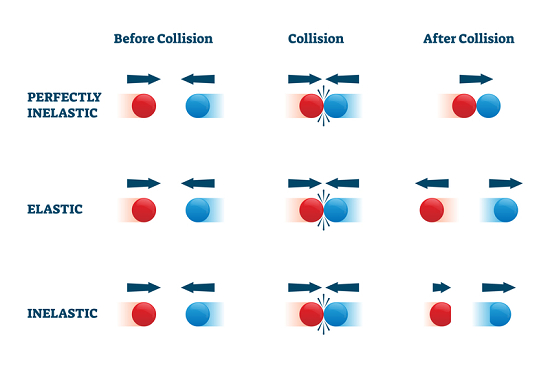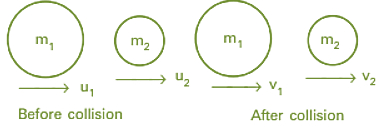Introduction
In our daily life, we experience many kinds of collisions. For example, in cricket, a ball collides with the bat. The direction of the ball and bat is towards each other before the collision and after the collision the energy, speed, and direction of the ball change. In a collision, the interaction between the particles is for a short interval of time but the applied force is relatively very strong on each other. Collisions may be elastic or inelastic.
What is Elastic Collision?
During the elastic collision, the kinetic energy or linear momentum of the bodies which collide is constant or in simple words conserved which means there is exactly no loss of kinetic energy. The collisions of the particles are elastic.

Explore our latest online courses and learn new skills at your own pace. Enroll and become a certified expert to boost your career.
What is an Inelastic Collision?
During the inelastic collision, the kinetic energy of the system, there is a loss of energy which means energy is not conserved and the particles stick with each other and then move. Momentum remains conserved. Initial Kinetic energy is always greater than final kinetic energy.
Types of Collision
Mainly there are two types of collision: One is elastic collision and the other is Inelastic collision. In the first case, the kinetic energy is constant whereas in the second case the kinetic energy is not conserved.
Law of Conservation of Linear Momentum
As we know, momentum is measured to be the multiplication of mass and the velocity of an object. Now from the law of conservation of linear momentum, if one object collides with another body, the total momentum of an object held before a collision is the same or equal to the total momentum of an object held after a collision.
Let, velocities initially before the collision be u1u1 and u2u2. and velocities final after the collision is v1v1 and v2v2. Mass is constant, so the mass remains constant after the collision. A force has an equal and opposite reaction.
F1=−F2F1=−F2
m1a1=−m2a2m1a1=−m2a2
m1(v1−u1)t=−m2(v2−u2)tm1(v1−u1)t=−m2(v2−u2)t
Time t has been canceled
m1v1−m1u1=−m2v2+m2u2m1v1−m1u1=−m2v2+m2u2
m1v1−m1u1=m2u2−m2v2m1v1−m1u1=m2u2−m2v2
m1v1+m2v2=m2u2+m1u1m1v1+m2v2=m2u2+m1u1
Or
m1u1+m2u2=m1v1+m2v2m1u1+m2u2=m1v1+m2v2
Hence, the total momentum held before the collision is equal to or the same as the total momentum held after the collision.
Elastic Collision in One Dimension

Fig:1 Elastic collision in one dimension
Suppose two bodies or objects having mass m1m1 and m2m2 move with straight or uniform line initially of velocities u1u1 and u2u2 as (u1u1 is greater than u2u2) and after the collision of bodies their velocities become v1v1 and v2v2 as (v2v2 is greater than v1v1)
According to the law of conservation of momentum,
m1u1+m2u2=m1v1+m2v2m1u1+m2u2=m1v1+m2v2
m1u1−m1v1=m2v2−m2u2m1u1−m1v1=m2v2−m2u2
m1(u1−v1)=m2(v2−u2)….(1)m1(u1−v1)=m2(v2−u2)….(1)
By the law of conservation of energy, KE is conserved
12m1u21+12m1u22=12m2v21+12m2v2212m1u12+12m1u22=12m2v12+12m2v22
12m1u21−12m1v21=12m2v22−12m2u2212m1u12−12m1v12=12m2v22−12m2u22
12m1(u21−v21)=12m2(v22−u22)12m1(u12−v12)=12m2(v22−u22)
m1(u21−v21)=m2(v22−u22)….(2)m1(u12−v12)=m2(v22−u22)….(2)
Dividing eq (2) by (1)
m1(u21−v21)m1(u1−v1)=m2(v22−u22)m2(v2−u2)m1(u12−v12)m1(u1−v1)=m2(v22−u22)m2(v2−u2)
(u1+v1)((u(1)−v1)(u(1)−v1)=(v2−u2)(v2+u2)(v2−u2)(u1+v1)((u(1)−v1)(u(1)−v1)=(v2−u2)(v2+u2)(v2−u2)
(As the same values canceled out)
(u1+v1)=(v2+u2)(u1+v1)=(v2+u2)
(u1−u2)=(v2−v1)(u1−u2)=(v2−v1)
Therefore relative velocity before the collision (u1−u2)(u1−u2) is equal to relative collision after collision (v2−v1)(v2−v1).
Elastic Collision in Two Dimension
From the conservation of energy,
Total Kinetic Energy(KE) held before the collision is always the same or equal to the total Kinetic Energy(KE) held after the collision.
12m1u21+12m1u22=12m2v21+12m2v2212m1u12+12m1u22=12m2v12+12m2v22
(1/2 will be canceled out, so we have)
m1u21+m1u22=m2v21+m2v22m1u12+m1u22=m2v12+m2v22
As linear momentum is constant,
Total linear momentum held before the collision is the same as total linear momentum held after the collision. For horizontal components
m1u1+m2u2=m1v1cosθ+m2v2cosθm1u1+m2u2=m1v1cosθ+m2v2cosθ
For vertical components
0=m1v1sinθ+m2v2sinθ0=m1v1sinθ+m2v2sinθ
The four unknown quantities, which are m1,m2,v1,u2,θm1,m2,v1,u2,θ, by measuring one of the four unknown quantities the value of the other three unknown quantities can be solved.
Inelastic Collision in One Dimension
In an inelastic collision, bodies stick to each other and move in the same direction as speed. Momentum is conserved but the kinetic energy may vary and change to different types of energy. Due to bodies stick each other, the conservation of momentum is,
m1u1+m2u2=(m1+m2)vm1u1+m2u2=(m1+m2)v
Here the final velocity becomes v and we find the value of v as:
v=m1u1+m2u2(m1+m2)v=m1u1+m2u2(m1+m2)
Also, the kinetic energy lost is given by,
KE=12m1u2−12(m1+m2)v2KE=12m1u2−12(m1+m2)v2
Inelastic Collision in Two Dimension
As we know total linear momentum of the system of any particles will remain constant which means total initial momentum is equal to total final momentum.
As we have,
m1u1+m2u2=m1v1cosθ+m2v2cosθm1u1+m2u2=m1v1cosθ+m2v2cosθ
0=m1v1sinθ−m2v2sinθ0=m1v1sinθ−m2v2sinθ

Inelastic collision in two dimension
As the bodies are stuck to each other,
m1u1cosθ+m2u2=(m1+m2)vcosθm1u1cosθ+m2u2=(m1+m2)vcosθ
Therefore the momentum on the left-hand side is equal to the linear momentum right side which is the final momentum. So this is the equation for perfectly inelastic collision. After the collision velocities become the same. so final velocity is denoted as v.
Examples of one and two dimension collision
Some examples related to the collision are:
- When you hit the basketball on the ground, it bounces back to your side. In this case, the kinetic energy remains constant, which means this example is of elastic collision.
- The collision between the small particles and the atoms is also an example of elastic collision.
- A boy playing football on the ground is an example of an inelastic collision.
- A muddy ball thrown to the wall sticks to it, this is for inelastic collision.
- If two cars hit each other is an example of an inelastic collision.
- If a ball of clay is dropped at some height it sticks also due to inelastic collision.
Leave a Reply